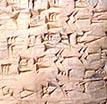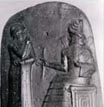


UNIDAD 9: LAS CIVILIZACIONES FLUVIALES
ACTIVITY 26: MESOPOTAMIA
1. Read the text.
What practices or characteristics define a civilization?
The development of cities, writing, and written law code, and more, happened first in the part of the world we call the ancient Near East. So, we sometimes think of it as the birthplace of western civilization.
The ancient Near East was a region of great diversity. It stretched from the eastern shore of the Mediterranean to the eastern border of present day Iran, but it was never one big country.
The people living here were from different cultural groups, for example the Sumerians, Akkadians, Assyrians, Babylonians, Persians, and more.
We won't be able to explore every culture from this fascinating region in depth. Instead we will learn more about the contributions these cultures made by investigating some of the objects that they left behind.
|
Click on the objects below to explore some of these characteristics...... |
 |
 |
 |
Information from: http://carlos.emory.edu/ODYSSEY/NEAREAST/homepg.html
2. Read the text.
The term civilization basically means the level of development at which people live together peacefully in communities. Ancient civilization refers specifically to the first settled and stable communities that became the basis for later states, nations, and empires. The
study of ancient civilization is concerned with the earliest segments of the
much broader subject called ancient history.
The span of ancient history began with the invention of
writing in about 3100 BC
and lasted for more than 35 centuries. Mankind existed long before the written
word, but writing made the keeping of a historical record possible.
The
study of ancient civilization is concerned with the earliest segments of the
much broader subject called ancient history.
The span of ancient history began with the invention of
writing in about 3100 BC
and lasted for more than 35 centuries. Mankind existed long before the written
word, but writing made the keeping of a historical record possible.
The single, decisive factor that made it possible for mankind to settle in permanent communities was agriculture. After farming was developed in the Middle East in about 6500 BC, people living in tribes or family units did not have to be on the move continually searching for food or herding their animals. Once people could control the production of food and be assured of a reliable annual supply of it, their lives changed completely.
People began to found permanent communities in fertile river valleys. Settlers learned to use the water supply to irrigate the land. Being settled in one place made it possible to domesticate animals in order to provide other sources of food and clothing.
Information from: http://web.archive.org/web/20041105085726/http://www.lksd.org/kongiganak/kongiganak/ContinuousEdCarnagie/Carnagie/WorldHistory/WldHistoryCh2/WldHistoryCh2EarlyCivilizations.htm

These early irrigation systems were more fully developed by the Sumerians in Mesopotamia
3. Summerian Religion.
 The
Sumerians believed that the world was created out of an an ancient sea from
whence the universe, gods, and people were created. They believed that the
universe was ruled by these gods, who were anthropomorphic (they had human
features and personalities) and who represented various natural phenomenon. Each
Sumerian city-state had its own patron deity to whom the citizens paid homage.
Temples, known as ziggurats, were often erected in the cities to honor and house
each city's god. The city of Ur,
for example, constructed a ziggurat for Nanna, the god of the moon.
The
Sumerians believed that the world was created out of an an ancient sea from
whence the universe, gods, and people were created. They believed that the
universe was ruled by these gods, who were anthropomorphic (they had human
features and personalities) and who represented various natural phenomenon. Each
Sumerian city-state had its own patron deity to whom the citizens paid homage.
Temples, known as ziggurats, were often erected in the cities to honor and house
each city's god. The city of Ur,
for example, constructed a ziggurat for Nanna, the god of the moon.
The key gods of the Sumerians were Enki (god of water), Ki (god of earth), Enlil (god of air), and An (god of heaven). These main gods were believed to have created the rules of Sumerian society to which all people were expected to adhere. Sumerians also believed that the reason for their existence was to delight the gods. The observance of certain rituals and animal sacrifices were considered necessary in order to satisfy these often capricious deities.
http://www.mnsu.edu/emuseum/prehistory/middle_east/sumer_religion.html
4. Write down five ideas about the ancient civilzation of Mesopotamia.